UAB Students Reimagine the Book
By Charles Buchanan
It seems that you can judge a book by its cover—if it’s one of the fanciful tomes created by students in UAB’s book arts course. You’re more likely to find these books in a gallery than on a bestseller list, however, because each volume is designed to be a unique work of art.
 |
Students in UAB's book arts program create their own unique works from scratch, combining centuries-old techniques with cutting-edge designs. The work above was created by Brooke Lancaster. |
“These pieces use the format of the book as an avenue for creative expression,” explains Doug Baulos, assistant professor of drawing and bookmaking in the UAB Department of Art and Art History. Each book’s structure, binding, paper, and printing are part of the art. “Content is not limited to words alone,” says Baulos, and in fact, some of the books contain no words at all.
Creating a book from scratch—and by hand—is a time-honored tradition. Centuries ago, it was the only way to make a book. Today, Baulos says, students from a variety of majors are eager to experiment with the techniques and materials that are part of the process. They also enjoy the challenge of seeing the book as an art form. “Sculpture students, for example, use the class to explore narrative, mass, and the book as object,” Baulos adds. “Graphic design majors use it as a professional practice course for layout, production, and so forth.”
(Story continues below slideshow)
Student Melissa Precise hasn’t decided whether she will pursue art or architecture as a career, but “the skills I learned in book arts will prove useful for constructing models or sculptures in the future,” she says. She and her colleagues learned how to make paper and decorate it with techniques such as marbling (creating multicolored patterns from ink floating on liquid), add words and images through printmaking and photography, and construct and bind their books using traditional and primarily natural materials. Some of the finished pieces incorporate bookcloth, waxed linen, leather, and wood. The students even made their own paste.
| Booking Now For more information on the bookmaking course, ARS 395, which is offered each semester, visit http://drawinguab.blogspot.com. |
“We created books the way the ancients did,” Precise says. “I felt like we were keeping an important part of culture alive.” On average, each book took about eight hours to make, she says, “which means that some required two hours, and others took 20.”
Baulos, an accomplished artist who began working with book arts in the 1980s, says bookmaking will continue to thrive even as e-books grow in popularity. “Art speaks to cultural and societal importance regardless of the media or application,” he explains. “I’m interested in the future of digital book arts as well as historical trends.”
“There’s something nostalgic and important about the physical form of the book itself,” Precise adds. “I love books not only for what they contain but also for the way they look, feel, smell, and sound.”